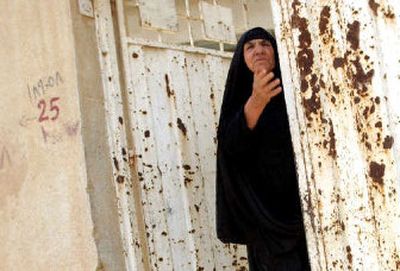Saddam-ordered 1982 massacre largely unreported

CAIRO, Egypt – At the time, it went nearly unnoticed.
The 1982 massacre in Dujail – the subject of Saddam Hussein’s trial that begins Wednesday – happened when few foreign journalists were based in Iraq, and the world’s interest was focused more on the threat from Iran.
Even inside Iraq, little was known about the assassination attempt on Saddam that led to the executions of nearly 150 people from Dujail. Critics have long contended more attention should have been paid – to all of his atrocities.
It was years before any real attention was paid to the retribution inflicted on Dujail, a town 50 miles north of Baghdad that was a center of opposition to Saddam.
Interviews with Dujail survivors since Saddam’s fall in 2003, including an Associated Press story in May 2003, have made the events there clearer. The Iraqi court trying Saddam and seven others will decide who was to blame.
At the time, the town was a stronghold of the Dawa Party, a Shiite Muslim movement that was staging attacks on Saddam’s secular Sunni-dominated regime to protest his war with neighboring Iran, a predominantly Shiite country.
As Saddam’s motorcade entered Dujail for a meeting on July 8, 1982, Dawa gunmen opened fire from palm groves, triggering a battle that lasted for hours. Iraqi army helicopter gunships and infantry finally rescued Saddam.
Secret police later rounded up families, razed the town’s fruit groves, destroyed houses and executed nearly 150 people, some as young as 13, after a summary trial, according to those who will testify.
One of the few contemporaneous accounts came in the Economist magazine, which on July 31, 1982, reported that Dujail had been the site of an “assassination attempt that looked more like a military engagement.”
Some four months later, on Dec. 2, 1982, the magazine reported the town had been “erased from the map,” apparently in retaliation by Saddam.
The next month, the Economist sent a reporter to Iraq – at the invitation of Saddam’s government, which had denied the Dec. 2 report.
He found a large swath of the village seemed to have been razed. The Economist noted, however, that its reporter did not talk to any Dujail townspeople, because to ask them what had happened could have meant their deaths at the hands of Saddam’s intelligence forces.
Saddam’s government didn’t acknowledge anything about events in Dujail for two years, and then only to report the assassination attempt on Saddam. That came in a book by the dictator’s half brother and chief of intelligence, Barzan Ibrahim Al-Tikriti, boasting of the notorious service’s ability to instill fear in the hearts of enemies.
The British Broadcasting Corp. on Wednesday posted on its Web site a gallery of what it said were newly discovered images taken from a film shot by Saddam’s official cameraman on July 8, 1982, showing the dictator being greeted by civilians in Dujail before addressing a crowd.
No images are shown of the assassination attempt. But Saddam, wearing army fatigues and a black beret, is later seen talking to a man identified as one of the surviving suspects after the others had been killed.
Saddam then returns to the town and addresses another large group of people, blaming the assassination attempt on “agents of foreigners” – an apparent reference to Iran – and promising to pursue the “small number of traitors” in Dujail.
Faisal Fikri, an Iraqi activist in the anti-Saddam dissident movement at the time, recalled recently that news about Saddam’s atrocities was circulating among Iraqi exiles. But Arab media, mostly government-controlled, were hesitant to write anything.
“We were begging them to tell the stories of how Saddam was ruling by fear and terror, and the answer was always shaking their shoulders,” Fikri said at his Cairo apartment while carrying a binder thick with papers and photos documenting Saddam’s crimes.
“It was a deliberate total blackout,” he said.
At the time, the Arab world stood firmly behind Saddam in his struggle against Persian Iran. Egypt, for example, which had the most vibrant press, reported little or nothing about the massacre.
The United States and the rest of the Western world also were focused on using Saddam as a bulwark against Iran, after the 1979 rise to power of the Islamic regime led by Ayatollah Ruhollah Khomeini.
Indeed, Western governments rarely spoke out against measures taken by Arab leaders to crush Islamic extremists. Five months before Dujail, for example, Syrian President Hafez Assad killed an estimated 20,000 people in the extremist hotbed of Hama with little protest internationally.
Another complicating factor was that the Dawa Party was widely perceived in the West as an instrument of the Iranian intelligence services. A year after Dujail, U.S. officials accused Dawa of bombing the U.S. Embassy in Kuwait.
While it is known that the U.S. government, for instance, knew about Iraq’s use of chemical weapons during its long war with Iran, it is unclear what Washington knew about Dujail or other abuses.
Some Arab critics say the lack of U.S. condemnation created a climate in which Saddam felt free to commit crimes.
Mamdouh el-Sheik, an Egyptian writer who has researched Saddam’s coverage by the world’s media, contends the Iraqi leader’s abuses occurred “not only with Western knowledge, but with Western consent and complicity.”